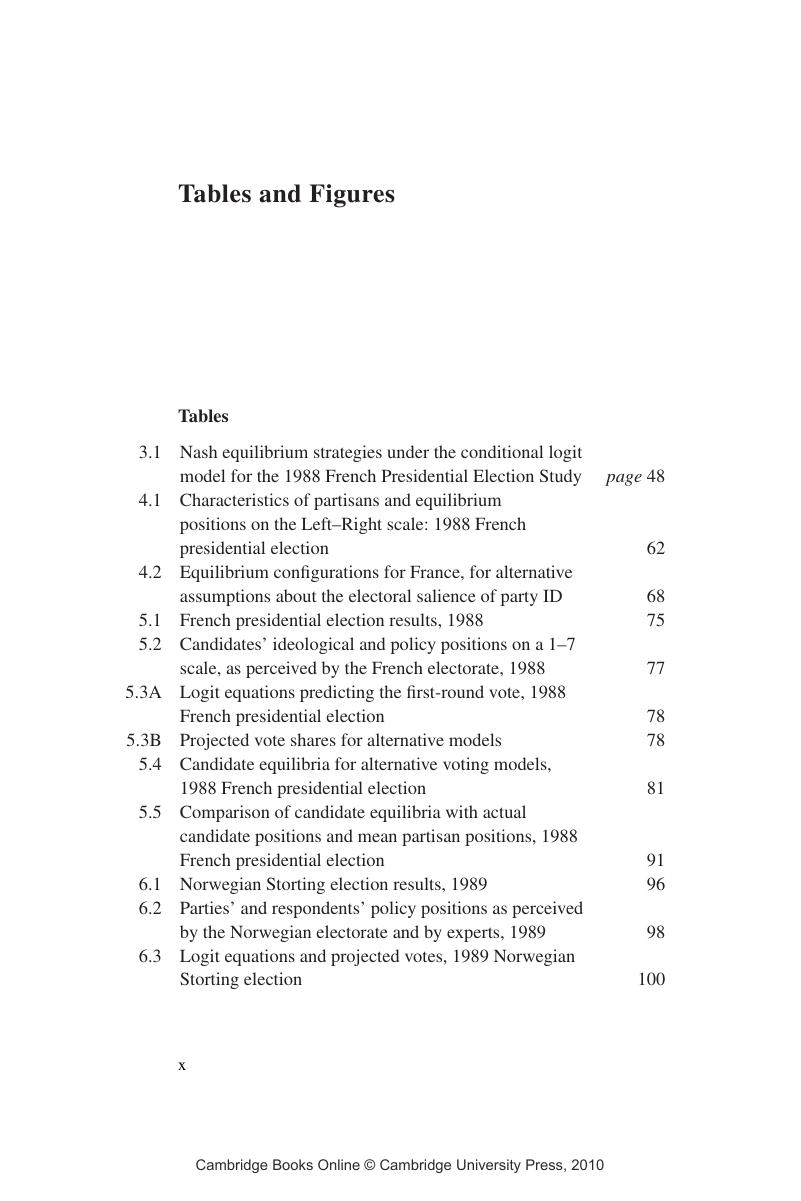 A Unified Theory of Party Competition
A Unified Theory of Party Competition Book contents
- Frontmatter
- Contents
- List of Tables and Figures
- Acknowledgments
- A Unified Theory of Party Competition
- 1 Modeling Party Competition
- 2 How Voters Decide: The Components of the Unified Theory of Voting
- 3 Linking Voter Choice to Party Strategies: Illustrating the Role of Nonpolicy Factors
- 4 Factors Influencing the Link between Party Strategy and the Variables Affecting Voter Choice: Theoretical Results
- 5 Policy Competition under the Unified Theory: Empirical Applications to the 1988 French Presidential Election
- 6 Policy Competition under the Unified Theory: Empirical Applications to the 1989 Norwegian Parliamentary Election
- 7 The Threat of Abstention: Candidate Strategies and Policy Representation in U.S. Presidential Elections
- 8 Candidate Strategies with Voter Abstention in U.S. Presidential Elections: 1980, 1984, 1988, 1996, and 2000
- 9 Policy Competition in Britain: The 1997 General Election
- 10 The Consequences of Voter Projection: Assimilation and Contrast Effects
- 11 Policy-Seeking Motivations of Parties in Two-Party Elections: Theory
- 12 Policy-Seeking Motivations of Parties in Two-Party Elections: Empirical Analysis
- 13 Concluding Remarks
- Appendix 1.1 Literature Review: Work Linking Behavioral Research to Spatial Modeling
- Appendix 2.1 Alternative Statistical Models of Voter Choice
- Appendix 2.2 Controversies in Voting Research: The Electoral Impact of Party Identification
- Appendix 2.3 Relationship between the Unified Discounting Model and the Directional Model of Rabinowitz and Macdonald
- Appendix 3.1 Spatial Models That Incorporate Valence Dimensions of Candidate Evaluation
- Appendix 4.1 Uniqueness Theorem and Algorithm for Computing Nash Equilibria
- Appendix 4.2 Proof of Theorem 4.1
- Appendix 4.3 Simulation Analysis and an Approximation Formula for Nash Equilibria
- Appendix 4.4 Derivations of Formulas Relating Electoral Factors to the Shrinkage Factor, ck
- Appendix 6.1 Equilibria for Outcome-Oriented Motivations: The Kedar Model
- Appendix 7.1 Proof of Lemma 7.1
- Appendix 7.2 Derivations for the Unified Turnout Model
- Appendix 8.1 Coding and Model Specifications
- Appendix 8.2 Alternative Turnout Models
- Appendix 11.1 Proof of Theorem 11.1
- Appendix 11.2 Empirical Estimation of the Mean and Standard Deviation of Valence Effects
- References
- Index
List of Tables and Figures
Published online by Cambridge University Press: 04 December 2009
- Frontmatter
- Contents
- List of Tables and Figures
- Acknowledgments
- A Unified Theory of Party Competition
- 1 Modeling Party Competition
- 2 How Voters Decide: The Components of the Unified Theory of Voting
- 3 Linking Voter Choice to Party Strategies: Illustrating the Role of Nonpolicy Factors
- 4 Factors Influencing the Link between Party Strategy and the Variables Affecting Voter Choice: Theoretical Results
- 5 Policy Competition under the Unified Theory: Empirical Applications to the 1988 French Presidential Election
- 6 Policy Competition under the Unified Theory: Empirical Applications to the 1989 Norwegian Parliamentary Election
- 7 The Threat of Abstention: Candidate Strategies and Policy Representation in U.S. Presidential Elections
- 8 Candidate Strategies with Voter Abstention in U.S. Presidential Elections: 1980, 1984, 1988, 1996, and 2000
- 9 Policy Competition in Britain: The 1997 General Election
- 10 The Consequences of Voter Projection: Assimilation and Contrast Effects
- 11 Policy-Seeking Motivations of Parties in Two-Party Elections: Theory
- 12 Policy-Seeking Motivations of Parties in Two-Party Elections: Empirical Analysis
- 13 Concluding Remarks
- Appendix 1.1 Literature Review: Work Linking Behavioral Research to Spatial Modeling
- Appendix 2.1 Alternative Statistical Models of Voter Choice
- Appendix 2.2 Controversies in Voting Research: The Electoral Impact of Party Identification
- Appendix 2.3 Relationship between the Unified Discounting Model and the Directional Model of Rabinowitz and Macdonald
- Appendix 3.1 Spatial Models That Incorporate Valence Dimensions of Candidate Evaluation
- Appendix 4.1 Uniqueness Theorem and Algorithm for Computing Nash Equilibria
- Appendix 4.2 Proof of Theorem 4.1
- Appendix 4.3 Simulation Analysis and an Approximation Formula for Nash Equilibria
- Appendix 4.4 Derivations of Formulas Relating Electoral Factors to the Shrinkage Factor, ck
- Appendix 6.1 Equilibria for Outcome-Oriented Motivations: The Kedar Model
- Appendix 7.1 Proof of Lemma 7.1
- Appendix 7.2 Derivations for the Unified Turnout Model
- Appendix 8.1 Coding and Model Specifications
- Appendix 8.2 Alternative Turnout Models
- Appendix 11.1 Proof of Theorem 11.1
- Appendix 11.2 Empirical Estimation of the Mean and Standard Deviation of Valence Effects
- References
- Index
Summary

- Type
- Chapter
- Information
- A Unified Theory of Party CompetitionA Cross-National Analysis Integrating Spatial and Behavioral Factors, pp. x - xviPublisher: Cambridge University PressPrint publication year: 2005
